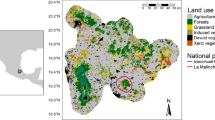The habitat preferences, seasonal activity cycles and optimum sampling protocols of an ant community in the Australian arid zone were assessed by pitfall trapping. Diversity and abundance of ants peaked in the hotter summer months and varied greatly between different habitats. Sand dunes vegetated with tall perennial shrubs proved to be the most useful habitat for environmental monitoring using ants. Dominant and genera were suppressed by environmental stresses caused by salt spray from an underground mine. Remediation of the salt spray resulted in a general, yet inconsistent, recolonization of dominant ants at the expense of opportunistic genera. A greater understanding of the ecology of key ant species is required before ants can be used as unequivocal indicators of environmental condition at the Olympic Dam mine site.
Similar content being viewed by others
References
Andersen, A.N. (1990) The use of ant communities to evaluate change in Australian terrestrial ecosystem: a review a recipe. Proc. Ecol. Soc. Aust. 16, 347–57.
Andersen, A.N. (1991) Sampling communities of ground foraging ants: pitfall catches compared with quadrat counts in an Australian tropical savanna. Aust. J. Ecol. 16, 273–79.
Andersen, A.N. (1993) The use of ants to assess restoration success following mining: a case study at Ranger Uranium Mine. In Conservation and Development in Northern Australia. (I. Moffatt and A. Webb, eds) Darwin: ANU Press.
Andersen, A.N. (1996) A classification of Australian ant communities, based on functional groups which parallel plant life-forms in relation to stress and disturbance. J. Biogeogr. 22, 15–29.
Andryszczak, H. (1992) Water control in exhaust ventilation raises and associated fan works. Proceedings of the 5th Underground Operators' Conference pp. 119–23. Ballarat, Victoria.
Badman, F.J. (1992) Drill pad rehabilitation at the Olympic Dam mine. In Proceedings of the Workshop on Rehabilitation of Arid and Semi-arid Areas. Kalgoorlie, Western Australia.
Bernstein, R.A. (1974) Seasonal food abundance and foraging activity in some desert ants. Am. Nat. 108, 490–8.
Briese, D.T. and Macauley, B.J. (1980) Temporal structure of an ant community in semi-arid Australia. Aust. J. Ecol. 5, 121–34.
Fatchen, T.J. and Associates (1989) Olympic Dam Vegetation Monitoring. General report November 1989–December 1990. Olympic Dam Operations, Olympic Dam.
Greenslade, P.J.M. (1973) Sampling ants with pitfall traps: digging in effects. Insects Sociaux 20, 343–53.
Greenslande, P.J.M. (1978) Ants. In The Physical and Biological Features of Kunnoth Paddock in Central Australia. (W.A. Low, ed). CSIRO Division of Land Resource Management Technical Paper No. 4.
Greenslade, P.J.M. (1979) A Guide to the Ants of South Australia. Special Education Bulletin Series South Australian Museum. Adelaide.
Greenslade, P. and Greenslade, P.J.M. (1971) The use of baits and preservatives in pitfall traps. J. Aust. ent. Soc. 10, 253–60.
Majer, J.D. (1978a) The ecology of ants in relation to bauxite mine rehabilitation. Bull. Ecol. Soc. Aust. 8, 9.
Majer, J.D. (1978b) An improved pitfall trap for sampling ants and other epigaeic invertebrates. J. Aust. ent. Soc. 17, 261–2.
Majer, J.D. (1983) Ants: bio-indicators of minesite rehabilitation, land use, and land conservation. Environmental Management 7, 375–83.
Majer, J.D. (1984) Recolonisation by ants in rehabilitated open cut mines in Northern Australia Reclamation and Revegetation Research 2, 279–98.
Majer, J.D. (1985) Recolonisation by ants of rehabilitated mineral sand mines on North Stradbroke Island, Queensland, with particular reference to seed removal. Aust. J. Ecol. 10, 31–48.
Majer, J.D., Day, J.E., Kabay, E.D. and Perriman, W.A. (1984) Recolonisation by ants in bauxite mines rehabilitated by a number of different methods. J. App. Ecol. 21, 355–75.
Olympic Dam Operations (1993a) Environmental Management Programme 1993. Olympic Dam, South Australia.
Olympic Dam Operations (1993b) Environmental Management Programme. Annual report 01/03/92–28/02/93. Olympic Dam, South Australia.
Olympic Dam Operations (1993c) Waste Management Programme. Annual Report. June 1992–May 1993. Olympic Dam, South Australia.
Read, J.L. (1994) A retrospective view of the quality of the fauna component of the Olympic Dam Project Environmental Impact Statement. J. Environ. Manage. 41, 167–85.
Whitford, W.G. and Ettershank, G. (1975) Factors affecting foraging activity in Chihuahuan desert harvester ants. Environ. Entomol. 4, 689–96.
Yeatman, E.M. and Greenslade, P.J.M. (1980) Ants as indicators of habitat in three conservation parks in South Australia. Sth. Aust. Nat. 55, 230–6.
Author information
Authors and Affiliations
Rights and permissions
About this article
Cite this article
Read, J.L. Use of ants to monitor environmental impacts of salt spray from a mine in arid Australia. Biodivers Conserv 5, 1533–1543 (1996). https://doi.org/10.1007/BF00052114
Received:
Revised:
Accepted:
Issue Date:
DOI: https://doi.org/10.1007/BF00052114




